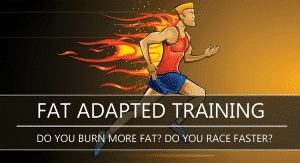Why do marathon cramps happen, even after running countless training miles, marathon-specific long runs, and paying special attention to your fueling and hydration needs?
In this video lesson, which is taken from our 3-part free video series, we’ll examine the roll running form plays in marathon cramping.
While I recommend you watch the video to help with some of the visual representations, sometimes reading is just plain faster. So, here’s the transcript:
Video Transcript
One of the most common reasons for failure in the marathon is suffering from muscle cramping. As many seasoned marathon veterans know, these muscle cramps can also be one of most frustrating reasons for a poor performance. Typically, when you suffer from a cramp, everything else is going pretty well. The pace feels easy, you’ve got plenty of energy, and a new PR seems almost inevitable. Then bang! Your calf cramps and it takes everything you have just to crawl to the finish.
As we’ve been taught to do from the billions of dollars funneled into the sports drink market every year, most runners blame a lack of fluid or electrolyte intake for their untimely cramp. So, for their next marathon they work on drinking more often.
Unfortunately, as many marathoners know, this rarely solves the problem. It seems know matter how often we drink or how precisely we try to optimize our electrolyte levels, the same darn calf cramp returns late in race.
This is because your marathon cramping isn’t likely a hydration or electrolyte issue at all. Rather, the problem is what we call a “muscle overloading” or a fatigue cramp. These occur when the neural mechanisms that are supposed to inhibit muscle contraction are depressed and the chemical and electrical synapses that fire the muscle fibers is enhanced. The result is an intense, sustained involuntary muscle contraction.
The question now is why do these fatigue cramps happen, even after running countless training miles, tough workouts and marathon-specific long runs?
How running form changes late in race
To answer this question, let’s first look at an interesting study conducted by Pete Larson at the 2009 Manchester City Marathon. Using a high speed camera, Larson filmed runners at the 10km and 32km points of the race, and later classified them according to their foot strike.
At the 10K mark, his results for 936 runners were as follows: Heel strike: 88.9%; midfoot: 3.4%; forefoot: 1.8%; asymmetrical 5.9%
At the 32K (20 mile) mark, Larson identified 286 runners of the above runners, displaying the following: Heel strike: 93% (87.8% were also heel striking at 10k.). Forefoot: 0%.
This brief study showed just how common it is to see a runner’s form change as they get tired later in a race. I doubt this data is surprising if you’ve ever watched a friend push through the final 10k of a marathon. Compared to their normal running technique, their form at the end of a race can look pretty ugly.
While I contend that footstrike itself is not the real issue, this study does confirm that our running form changes late in a race. But how does this relate to cramping?
How poor form leads to marathon cramping
As we learned in the previous two videos on muscle activation and treating the cause of running injuries, your body will always compensate when one muscle group isn’t working correctly by rerouting the work that needs to be done to another muscle group.
To quickly recap, if your glute muscle is inhibited and not firing correctly, your leg won’t simply stop working. Instead, your brain tells your muscles, “hey, this glute isn’t getting the job done, let’s fire the calves more forcefully to make up for the lack of power.” This “rerouting” occurs unconsciously and often you’ll never even realize it occurs.
Let’s look at two very specific and common examples of form breakdowns that occur late in a marathon and how they potentially impact cramping.
Slouching and poor posture
One of the most common issues is slouching, or leaning at the waist, as you get tired. Keeping your shoulders and chest back and your spine in a neutral position for two, three, or even four hours is a difficult task for your core (hips, abdominals, lower back and glutes). Most runners lack the strength to hold themselves in the optimal posture for three to four hours.
As a result of their weakness, they slouch (or lean forward at the waist), which will tend to sit the butt backward to counter balance their upper body’s forward position. This results in over-striding (landing with your foot out in front of your center of mass), which dramatically increases the impact forces that travel up the leg as the foot lands.
Over striding also puts the hamstrings in a vulnerable position at ground contact and forces them to do more work to pull the leg through since the glutes can’t be activated as efficiently. If you suffer from frequent hamstring cramps during the marathon, I contend this is the likely cause.
Lack of hip extension
I believe one of the main culprits of marathon cramping, especially in the calves, is a product of reduced hip extension, which is much more difficult to recognize than slouching.
Hip extension is the act of driving your entire upper thigh (and leg for that matter) backwards after your foot contacts the ground. The power for this movement is generated primarily from the hip and glutes and it is perhaps the single most important factor in your ability to run faster. The more powerful your hip extension, the faster you will go.
As you get further into a race, the forceful contractions required from the hip and glute muscles to sustain a fast pace become more difficult to generate (this is especially true if you went out too fast and fatigued your intermediate muscle fibers early). To compensate for the hip and glute getting tired, the body recruits the calf and quad to help generate the power needed to maintain marathon pace. Since the calf and quad aren’t accustomed to such a large workload, they quickly fatigue and begin to cramp.
How to address the issue
Now that we understand how form deterioration can lead to marathon cramping, how do we go about addressing the issue?
Just like you need to perform core and injury prevention work to stay healthy, it’s important you perform form-specific strengthening exercises that target the mechanics that commonly deteriorate late in a race.
For example, if you tend to suffer from calf or quad cramps late in a race, you’ll want to
perform exercises, drills and stretches that focus on improving your hip extension. Not only will this reduce many of the limitations that may be preventing you from generating proper hip extension, these exercises will help you improve your muscular endurance and ability to generate proper hip extension late in a race when you’re tired.
You can download a free sample of our hip extension specific routine under this video. It is available in PDF and Video format. I suggest implementing it after your harder running days, following the hard days hard, easy days easy philosophy. You can add it to other strength work you do as well.
Adding this type of form-specific work could be just what you need to prevent those late race cramps and help you reach your potential.
So far, we’ve talked about injuries, footwear, and now how form can impact something like marathon cramps. But, we’ve kept things pretty general. In the final video of this series, I am going to tell you how to put it all together to create the perfect running form for you. So, stay tuned to get all the details!
If you’ve enjoyed this video, check out our 3-part free video series and stay tuned for next week as we’re going to look more in-depth at some of the research on injury risk as you get tired during long runs. Also, in case you missed it, we covered how fatigue impacts running form during shorter races and speed workouts yesterday.





One Response
Lately when i do a half my quads hurt early on preventing me from running as much what is the cause?